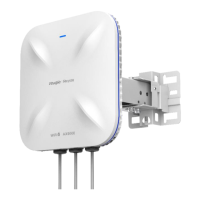Cookbook Getting Started
11
2.2.2 Installation Site Requirement
The installation site must meet the following requirement to ensure normal working and a prolonged durable life
of Reyee APs.
Ventilation
When installing devices, reserve at least 10 cm distances from both sides and the back plane of the cabinet at
ventilation openings to ensure good ventilation. After cables have been connected, bundle or place the cables
on the cabling rack to prevent them from blocking the air inlets. It is recommended that the device be cleaned
at regular intervals. In particular, avoid dust from blocking the screen mesh on the back of the cabinet.
Temperature and Humidity
To ensure normal operation and prolong the service life of the AP, keep proper temperature and humidity in the
equipment room.
If the temperature and humidity in the equipment room do not meet the requirements for a long time, the AP
may be damaged.
In an environment with a high humidity, insulating materials may have bad insulation or even leaking electricity.
Sometimes the materials may suffer from mechanical performance change and metallic parts may get rusted.
In an environment with a low humidity, insulating strips may dry and shrink. Static electricity may occur easily
and endanger circuits on the device.
In an environment with a high temperature, the AP is subject to more serious harm. Its performance may
degrade drastically and various hardware faults may occur.
Cleanness
Dust poses a severe threat to the running of the AP. The indoor dust falling on the AP may be adsorbed by the
static electricity, causing bad contact of the metallic joint. Such electrostatic adsorption may occur more easily
when the relative humidity is low. This affects the lifecycle of the AP and causes communication faults.
Grounding
A good grounding system is the basis for stable and reliable operation of the device, preventing lightning strokes
and resisting interference. Carefully check the grounding conditions at the installation site according to the
grounding requirements, and perform grounding operations properly as required.
Lightning Grounding
The lightning protection system of a facility is an independent system that consists of the lightning rod, down
conductor, and connector to the grounding system, which usually shares the power reference ground and ground
cable. The lightning discharge ground is targeted for the facility.
EMC Grounding
The grounding required for EMC design includes the shielding ground, filter ground, noise and interference
suppression, and level reference. All the above constitute the comprehensive grounding requirements. The
resistance of earth wires should be less than 1 Ω.
EMI
Electro-Magnetic Interference (EMI), from either outside or inside the device or application system, affects the
system in the conductive ways such as capacitive coupling, inductive coupling, and electromagnetic radiation.

